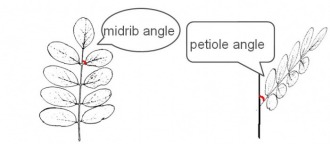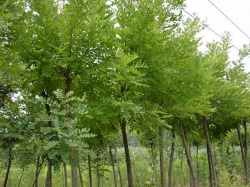Background
Unlike most animals, plants are sessile and cannot flee in response to acute stress. Many plants have developed defensive responses such as the mechanical movement of leaves, frequent in leguminous species (Kato et al. 2003; Liu et al. 2007). Phenotypic plasticity in the whole plant is an adaptive mechanism that aids drought tolerance and light acclimation (Wang et al. 2006; Guo et al. 2007). Alteration of foliar physiognomy is an important part of plasticity, as the leaf is a vital organ in photosynthesis (Mediavilla and Escudero 2003; Galme´s et al. 2007).
Seedlings development is the most critical periods in the life-cycle of trees, and the morphological and physiological leaf attributes during these periods are key factors in tree species adaptation. It is very important to reveal the adaptive mechanisms used by R. pseudoacacia in response to diverse light and water conditions, which may provide useful information for plant biologists and may be important in guiding the maintenance and restoration of vegetation.
Seedlings development is the most critical periods in the life-cycle of trees, and the morphological and physiological leaf attributes during these periods are key factors in tree species adaptation. It is very important to reveal the adaptive mechanisms used by R. pseudoacacia in response to diverse light and water conditions, which may provide useful information for plant biologists and may be important in guiding the maintenance and restoration of vegetation.
figure 3. the midrib and the petiole angles

Usually plants avoid the light stress throught the movement of leaves angles(midrib angle, petiole angle et al.)(Zhang Shouren et al.2001;Jiang Chuangdao et al.2005). Different types of leaves angles movement have different objectives. The purpose of azimuth angles changes is solar tracking;The movement of the midrib and petiole angles consists in the nyctinasty and thigmotrophic movement, and was effected by the water and light significantly.(Nilsen, 1985;
Simon et al., 2000; Minoru et al., 2002)
Simon et al., 2000; Minoru et al., 2002)
Research Objective
The objective of this study was to investigate (1) how leaves move under different conditions of light and water and (2) whether adaptive mechanisms can protect the leaves of R. pseudoacacia against shade and water stress.
The changes of the midrib angles, petiole angles and azimuth angles could reveal how the light and water stresses effect the R. pseudoacacia and how they respond.
The changes of the midrib angles, petiole angles and azimuth angles could reveal how the light and water stresses effect the R. pseudoacacia and how they respond.
Importance of this research
figure 4. the forest of the R.pseudoacacis

The black locust tree Robinia pseudoacacia L. was widely planted for its adaptability and aggressive growth. It has an important role in vegetation restoration and ecosystem regeneration. Limestone, which is easy to dissolve and penetrate, is the representative mountain component in Shandong Province. Anthropization have perturbed the vegetation in this area and drought occurs frequently (Wang and Zhou 2000). In addition, the stand is simplex due to artificial planting and allelopathy. It is easy to beget diseases to mature trees and lead to forest gaps. Fluctuating light conditions have effects on the growth of seedlings.
References
1. Kato E, Nagano H, Yamamura S, Ueda M (2003) Synthetic inhibitor of leaf-closure that reveals the biological importance of leaf-movement for the survival of leguminous plants. Tetrahedron 59:5909–5917.
2. Liu CC, Welham CVJ, Zhang XQ, Wang RQ (2007) Leaflet movement of Robinia pseudoacacia in response to a changing light environment. J Integr Plant Biol 49:419–424.
3. Wang GG, Bauerle WL, Mudder BT (2006) Effects of light acclimation on the photosynthesis, growth, and biomass allocation in American chestnut (Castanea dentata) seedlings. For Ecol Manage 226:173–180.
4. Guo WH, Li B, Zhang XS, Wang RQ (2007) Architectural plasticity and growth responses of Hippophae rhamnoides and Caragana intermedia seedlings to simulated water stress. J Arid Environ 69:385–399.
5. Mediavilla S, Escudero A (2003) Mature
tree versus seedlings:differences in leaf traits and gas exchange patterns in three co-occurring Mediterranean oaks. Ann Sci 60:455–460.
6. Galme´s J, Medrano H, Flexas J (2007) Photosynthesis and photoinhibition in response to drought in a pubescent (var. minor) and a glabrous (var. palaui) variety of Digitalis minor. Environ Exp Bot 60:105–111.
7. Zhang SR, Ma KP, Chen LZ (2002) Photosynthetic gas exchange and leaflet movement of Robinia psedoacacia in relation to changing light environments. Acta Bot Sin 44:858–863.
8. Jiang CD, Gao HY, Zou Q, Jiang GM, Li LH (2006) Leaf orientation, photorespiration and xanthophylls cycle protect young soybean leaves against high irradiance in field. Environ Exp Bot 55:87–96
9. Wang RQ, Zhou GY (2000) The vegetation of Shandong Province. Shandong Science and Technology Publication, Jinan, pp 153-156.
2. Liu CC, Welham CVJ, Zhang XQ, Wang RQ (2007) Leaflet movement of Robinia pseudoacacia in response to a changing light environment. J Integr Plant Biol 49:419–424.
3. Wang GG, Bauerle WL, Mudder BT (2006) Effects of light acclimation on the photosynthesis, growth, and biomass allocation in American chestnut (Castanea dentata) seedlings. For Ecol Manage 226:173–180.
4. Guo WH, Li B, Zhang XS, Wang RQ (2007) Architectural plasticity and growth responses of Hippophae rhamnoides and Caragana intermedia seedlings to simulated water stress. J Arid Environ 69:385–399.
5. Mediavilla S, Escudero A (2003) Mature
tree versus seedlings:differences in leaf traits and gas exchange patterns in three co-occurring Mediterranean oaks. Ann Sci 60:455–460.
6. Galme´s J, Medrano H, Flexas J (2007) Photosynthesis and photoinhibition in response to drought in a pubescent (var. minor) and a glabrous (var. palaui) variety of Digitalis minor. Environ Exp Bot 60:105–111.
7. Zhang SR, Ma KP, Chen LZ (2002) Photosynthetic gas exchange and leaflet movement of Robinia psedoacacia in relation to changing light environments. Acta Bot Sin 44:858–863.
8. Jiang CD, Gao HY, Zou Q, Jiang GM, Li LH (2006) Leaf orientation, photorespiration and xanthophylls cycle protect young soybean leaves against high irradiance in field. Environ Exp Bot 55:87–96
9. Wang RQ, Zhou GY (2000) The vegetation of Shandong Province. Shandong Science and Technology Publication, Jinan, pp 153-156.
